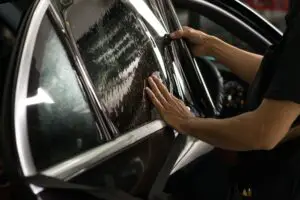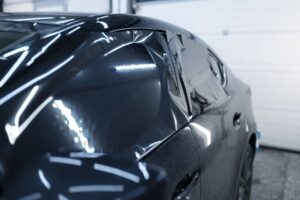Window tint laws were introduced into the state of New Hampshire in 1990 and encompass various areas but are mostly related to the amount of VLT your tints should be and how much reflective they can get.
New Hampshire window tint laws have their windows bounce between 70% and 35% VLT requirements, with windows such as the windshields having 35% VLT requirements on top of various other limitations.
I will go over all of these limitations and try my best to explain them to you while addressing any questions you may have, so make sure to read the article to the end to get the most information to avoid breaking any laws.
Table of Contents
- 1 How Much Tint Darkness Is Legal In New Hampshire?
- 2 Window Tint Reflection And Tint Colors
- 3 Medical Exemption Of Window Tint Laws In New Hampshire
- 4 Get A Certified Sticker From The Company
- 5 Other Window Tint Law Rules And Regulations In New Hampshire
- 6 Cost Of Car Window Tint In New Hampshire
- 7 Frequently Asked Questions
- 8 Conclusion
How Much Tint Darkness Is Legal In New Hampshire?

While each window is subject to its tint darkness requirement, most windows are either restricted to 70% VLT or 35% VLT.
It is better to go for the higher one to avoid any problems whatsoever in either case. Tints below 35% are completely illegal.
Tint Darkness Limit For SUVs And Vans
When it comes to sports utility vehicles and vans, the first thing that you need to worry about is the front windshield that can have a tint, but it is only limited to 35% VLT.
This tint cannot be reflective and must be limited to the top 6 inches of the windshield.
The front-seat side windows are even stricter for their VLT requirements by having the minimum amount be 70% VLT.
This is then taken down for the back seat side windows, which go back to 35% VLT. Finally, you have the rear window, which continues the trend of having a 35% VLT requirement.
Tint Darkness Limit For Sedans
Sedans in New Hampshire usually follow the same batch of rules as set for SUVs and vans, which you should be able to notice in this section.
1. Front Windshield
You are only allowed to use non-reflective tints on the front windshield. Any tint that you apply to the windshield must be limited to the top 6 inches of the windshield.
Along with this, the tint must have at least 35% VLT. Anything less will make you risk getting into trouble.
2. Front Seat Side Windows
Limited to 70% or more, the front seat side windows must allow at least 70% of outside light to enter the vehicle.
3. Rear Window
The rear window integrates the VLT requirements from the front windshield and removes everything else, meaning you only have to worry about maintaining at least 35% VLT for any tints you apply to that window.
4. Back Seat Side Windows
This is the same case for the back seat side windows, which should have at least 35% of outside light enter the vehicle.
Window Tint Reflection And Tint Colors
- There are many different rules established that govern the amount of reflection you can have on your window tints.
- The state of New Hampshire has banned metallic and mirrored appearances on the front seat side windows of both sedans and SUVs.
- Sedans and SUVs can also not have mirrored or metallic tints on their back seat side windows.
- The state of New Hampshire has not restricted any colors for tinting windows. So you can tint your windows as you like.
Medical Exemption Of Window Tint Laws In New Hampshire

Many people benefit from medical exemptions given by the law and help in various areas.
When it comes to window tint laws, medical exemptions can help people with various skin conditions or illnesses that find pain or discomfort in the sun’s rays.
For people like these, New Hampshire has allowed medical exemptions.
However, these exemptions are very limited as the only benefit they provide is allowing you to apply window tints that are as low as 35% VLT.
This is only applicable for the front seat side windows and the front windshield.
This applies to the windshield, as you can tint your entire windshield but only up to a minimum of 35% VLT. You are required not to fall below this threshold.
If you would like to apply for a medical exemption, you must first get a letter from your doctor that states why you need to tint your windows darker than usual.
This letter should contain basic information such as your name and date of birth. You must always have this letter with you when driving a car with darker tints.
Get A Certified Sticker From The Company
Many states have made it necessary to have stickers or other documents with you at all times when driving vehicles with tinted windows.
This is not the case for the state of New Hampshire. Here, having stickers is recommended by the state but is not required.
While you should try and have a sticker applied to help law enforcement identify that you have legal tints, you are not obligated to do so.
This applies to window tint manufacturers as well, who are not required to provide any certifications which state that the films they are producing are working in tandem with the state’s standards.
Other Window Tint Law Rules And Regulations In New Hampshire
While I have discussed the more important rules, I will talk about a few less obvious rules and regulations that are just as important.
- If you have your back windows tinted, you must have dual side mirrors.
- You are not required to have any official documents or stickers to prove that the tints you have applied are legal.
- The state does not have any rules when it comes to VLT variance.
- The state does allow medical exemptions.
Cost Of Car Window Tint In New Hampshire
If you are planning to get the best of the best when it comes to tints, you should be prepared to spend upwards of $400.
This is the cost of high quality and premium tints such as ceramic window tints. On the other hand, you can also purchase basic tints, starting at $100.
All of this depends on the quality of the tint you desire, along with other factors such as the color of the tint and the number of windows of the vehicle.
Frequently Asked Questions
Q1. Is 15% Tint Legal In New Hampshire?
15% tints are completely illegal in the state of New Hampshire.
The minimum amount of VLT you can have on any window is 35%, making 15% very small and too dark in comparison.
You should avoid applying 15% tints if you are in New Hampshire.
Q2. Are 5% Tints Legal In New Hampshire?
Since the state only allows a minimum of 35% VLT on window tints, it should be evident that 5% tints will not be allowed.
If you use 5% tints in New Hampshire, you will be breaking the law.
Q3. Is Limo Tint Legal In New Hampshire?
Limo tints also have the quality of being very dark. In that case, you should avoid them, as they will most likely fall below the state’s VLT requirements, making them illegal to apply.
Q4. Can I Get Pulled Over For Tint In New Hampshire?
If the police believe that you are using tints that are darker than what the state requires, then there is a good chance you will be pulled over by the police, who will check your tints and confirm if they are legal.
Q5. How Much Is A Tint Ticket In New Hampshire?
If you end up getting a tint ticket, you will be asked to pay a fine of $93. This is the price according to the latest legislation set by the state.
Conclusion
New Hampshire tint laws have a lot of different things to remember and take note of.
The laws and regulations set by the state were updated back in 2020, and new legislation is set to pass in July of this year as well, which you should be aware of planning on getting your car windows tinted.
By now, you should have a firm grasp on the rules and regulations set by the state of New Hampshire and should be easily able to follow them, making sure that your window tints abide by the laws and do not garner the suspicion of local law enforcement.

I am Tahir Azam, and I have been writing amazing articles for TaxiHack for as long as I can remember. I know everything that is to know when it comes to automobiles and is always on top of industry news and developments. While I am not an expert by any means, I pride myself on knowing the ins and outs of many different problems and, of course, their solutions. The articles on our website are some of the best and well-researched content that you will find, and I spend countless hours making sure this remains to be true. This is why I ask you to take your time out and read some of my articles, especially if you find a topic that resonates with you or is something you are looking into. This way, you will find the perfect mix of information and tips on your desired topic. Learn more about Tahir.



